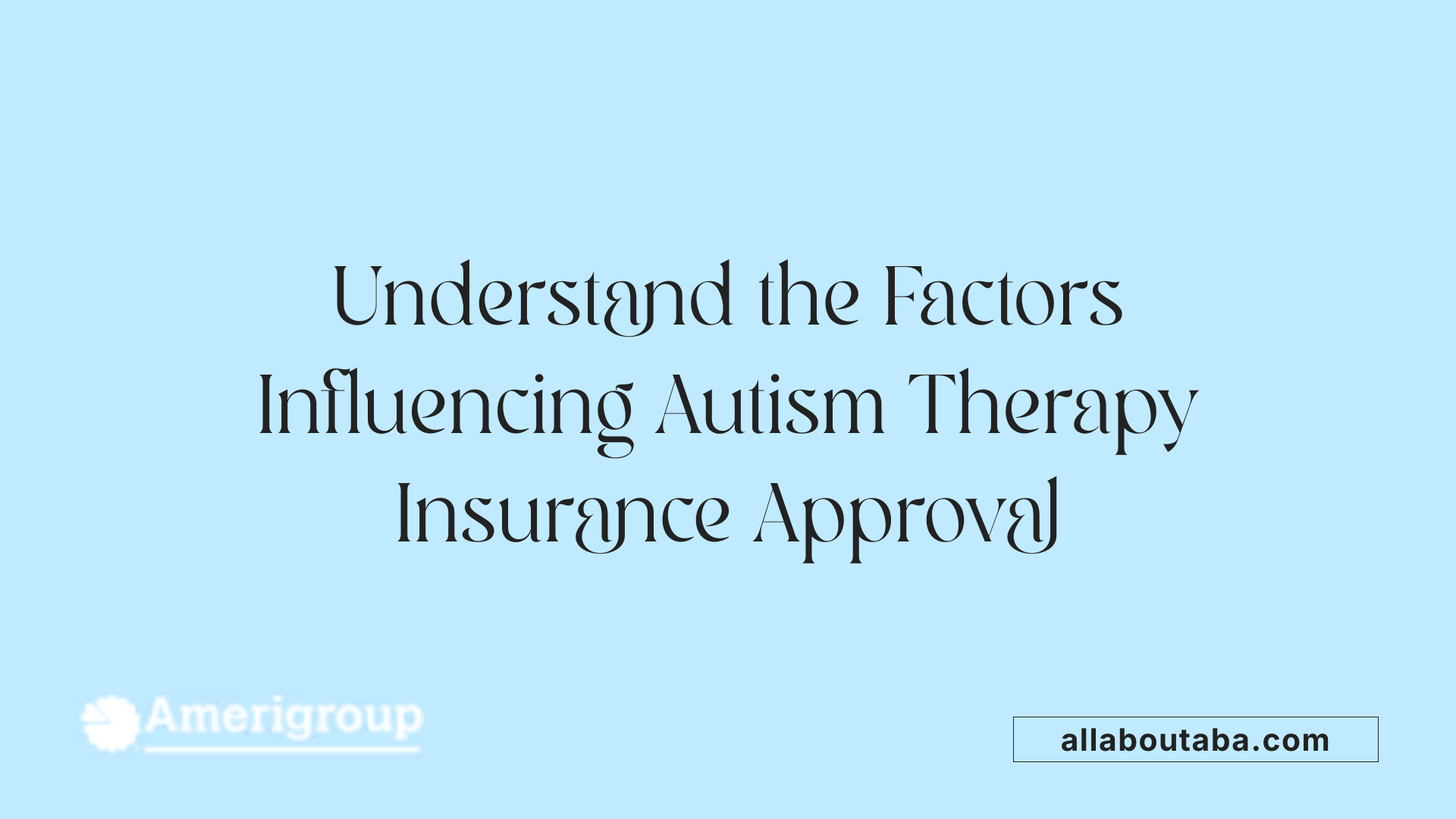Unlocking Autism Therapy Access Through Understanding Insurance
Navigating the complexities of insurance coverage for autism therapies like Applied Behavior Analysis (ABA) can be daunting for families. With comprehensive federal mandates, state-specific laws, and varied insurance plan requirements, understanding your rights, coverage options, and advocacy strategies is essential. This article provides an in-depth guide to help families effectively navigate insurance processes, maximize benefits, and ensure that children with autism receive the necessary treatments, especially in the context of evolving legal protections and diverse insurance plans.
Understanding Federal and State Insurance Mandates for Autism Therapy

Is ABA therapy covered by insurance?
Applied Behavior Analysis (ABA) therapy is generally accessible through insurance plans across the United States, thanks to comprehensive legal mandates. A federal requirement now mandates that all 50 states provide insurance coverage for ABA services for individuals with an autism diagnosis. By 2021, every state had adopted such mandates, significantly improving access to this necessary treatment.
Most major private insurance providers, including Blue Cross Blue Shield, UnitedHealthcare, Aetna, Cigna, and Humana, offer coverage for ABA therapy. Medicaid programs nationwide also include coverage for children diagnosed with autism, often with specific provisions and limits. The specifics of coverage—such as session limits, age restrictions, and provider requirements—vary depending on the insurance plan, state regulations, and whether the plan is private or public.
To qualify, individuals typically need a formal diagnosis confirmed by a qualified medical professional, and many plans require prior authorization before starting therapy. Families are advised to review their insurance policies carefully, inquire about coverage details, and understand any limits or out-of-pocket costs involved.
In summary, while ABA therapy is widely covered, the extent of the coverage depends on the individual insurance plan, state laws, and compliance with regulatory requirements. Checking with the insurance provider directly ensures clarity around specific benefits and procedures.
How Insurance Processes and Requirements Impact Autism Therapy Approval

What factors influence whether insurance will approve autism therapy, including ABA?
Several aspects determine if an insurance plan will authorize autism therapies such as Applied Behavior Analysis (ABA). Primarily, establishing medical necessity through detailed documentation from qualified professionals is critical. This includes diagnostic reports confirming ASD diagnosis, treatment plans, and ongoing progress assessments.
Accurate coding on billing submissions, timely completion of pre-authorization procedures, and selecting credentialed providers can significantly influence approval rates. Policies vary by carrier, so understanding specific denial codes and appeal procedures helps families respond effectively when claims are denied.
Network status is also crucial—using in-network providers reduces hurdles, while out-of-network services may require additional authorization or incur higher costs. Eligibility checks ensure services are provided within plan parameters, including adherence to dosage and billing limits such as Medically Unlikely Edit (MUE) caps, which restrict the number of claims per diagnosis per day. These factors combined shape whether insurance approves or denies autism therapy services.
Legal Protections and Advocacy Strategies for Autism Coverage

What legal protections and mandates support autism therapy coverage by insurance?
In the United States, several laws and regulations work together to ensure insurance coverage for autism therapies like applied behavior analysis (ABA). Federal laws such as the Affordable Care Act (ACA) prohibit insurance companies from denying coverage based on pre-existing conditions, which includes autism. The ACA has made mental and behavioral health services more accessible, requiring plans to include these treatments.
The Mental Health Parity and Addiction Equity Act (MHPAEA) plays a vital role by requiring that mental health services, including those for autism, are covered equally to medical and surgical benefits. This means insurance providers must offer comparable coverage for mental health conditions and physical health issues.
Since 2014, Medicaid programs nationwide have been mandated to provide necessary diagnostic and treatment services for children with autism, through the Early and Periodic Screening, Diagnostic, and Treatment (EPSDT) benefit. EPSDT ensures coverage for essential services, regardless of state-specific limits.
Most states have also enacted their own laws mandating autism insurance coverage, often requiring coverage for ABA, speech, occupational, and physical therapies. These state laws may specify age limits, benefit caps, and provider qualifications, and they are enforced by regulatory agencies. For example, Florida's law requires coverage with certain caps, while other states have broader mandates.
Additionally, legislation such as Wisconsin’s Autism Insurance Mandate and Senate Bill 946 exemplify state efforts to reinforce these protections. It is important to note that self-funded employer plans, regulated under federal law (ERISA), are generally exempt from state mandates but are subject to federal protections.
Overall, the landscape of insurance coverage for autism treatments is supported by a combination of federal laws and state mandates, creating a comprehensive legal framework designed to improve access and ensure necessary services are available to individuals with autism.
Maximizing Insurance Benefits and Resources for Autism Therapy

Are there resources or tips to help maximize insurance benefits for autism therapy?
To get the most out of your insurance benefits for autism therapy, it’s important to stay organized and informed. Begin by thoroughly reviewing your insurance policy at least once a year to understand what therapies are covered, such as ABA, speech, and occupational therapy. Pay attention to details including in-network provider requirements, deductibles, co-pays, and any service limits or age restrictions.
Ensure that your provider's documentation aligns with insurance requirements for medical necessity. This typically includes a formal diagnosis from a qualified healthcare professional and a detailed treatment plan. Advocating effectively involves gathering all necessary paperwork and staying current on relevant laws like the Mental Health Parity Act, which helps ensure equal coverage for mental health services.
When insurance denies a claim, don’t hesitate to file an appeal. Support from advocacy organizations and legal aid resources can enhance your chances. Utilization of financial tools such as Flexible Spending Accounts (FSAs), Health Savings Accounts (HSAs), and ABLE accounts can also help offset costs.
Additional support is available through grants and assistance programs. Medicaid, the United Healthcare Children’s Foundation, and state-specific programs often provide financial aid or supplemental coverage options.
Overall, active management, advocacy, and utilization of available resources combine to optimize your insurance benefits for autism therapies.
Empowering Families to Access Critical Autism Treatments
Navigating insurance coverage for autism therapies like ABA involves understanding a complex legal and procedural landscape. Families should leverage federal and state protections, conduct thorough policy reviews, and develop proactive advocacy strategies. By staying informed, maintaining detailed documentation, and utilizing available resources, parents and caregivers can improve access to essential treatments and ensure children receive the support they need for optimal development. Staying engaged with advocacy organizations and staying current on policy changes is key to maximizing insurance benefits and reducing the financial and emotional burden of autism therapy.
References
- Insurance Coverage for ABA Services - TherapyWorks
- ABA Therapy Coverage by Insurance in Texas (In Plain Language)
- Navigating Your Health Insurance Benefits and Coverage
- Navigating Insurance for ABA Services: A Parent's Guide to ...
- Navigating Insurance Approvals for ABA Therapy in Colorado
- Navigating Insurance Changes For Autism Therapy
- Health insurance coverage for autism | Autism Speaks
- Is ABA Therapy Covered by Insurance in Florida?







